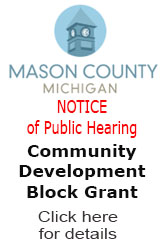
Thoughts on partisanship, future of Ludington.
Editor’s Note: The following is a submission to Mason County Press by Ludington Mayor Steve Miller. The views and opinions of the writer do not necessarily reflect those of this news organization.
By Mayor Steve Miller, City of Ludington.
I’d like to share two thoughts that will hopefully convey my view of my position within Ludington’s city government and a view of the city’s future from the office of the mayor.
First, given the extremely binary political climate at all levels of government, to be most effective, it’s essential that I maintain a non-partisan focus, even in the face of severely polar opposite attitudes.
The city of Ludington is my focus. It’s my arena. I wake everyday with the voices of 8,076 citizens in my head. And, I’m obligated to respond to each and every one of them-regardless of how they lean politically.
In addition, irrespective of their political affiliations, I have a responsibility to establish and maintain positive, constructive relationships with government officials, from the county level, to our state representative and state senator, to the governor’s office.
Those relationships, along with the working relationship I have with city council and administrators, continue to help me understand my role and have helped form my vision/opinion of Ludington’s future.
The future of Ludington is the second thought I’d like to address.
At its peak in 1950, the population of Ludington had grown to 9,500 citizens. By 2000, it had dropped to 8,300. Today, it struggles to remain over 8,000.
However, from its first settlement to today, hard work, perseverance, and success have fostered the culture of Ludington.
Throughout its storied 146 years, the history of Ludington has seen dramatic change. The earliest years of a logging and shipping commerce, and the rise of a light industrial manufacturing base formed the foundation of our community. But economies of scale have pushed those industries into the past.
Respecting that heritage, it’s time to truthfully admit what remains and embrace what we can control. Depending on the outlook, it could take an uncomfortable course of change to facilitate the next phase of our city’s metamorphosis.
As we find ourselves at the threshold of a complicated decision, we all must fully accept the idea that our personal histories and memories no longer translate as they once did.
Do we remain steadfast in the thinking that an ever-shrinking class of manufacturers will converge on our town to fill the shells of deserted factories that have sat empty for decades?
Will we wait and hope for the Hail Mary attempt of an unknown enterprise to bless us with large numbers of high paying jobs?
Do we cling to the unlikely prospect of our current local economy suddenly producing suitable wages and plentiful, affordable housing for the hundreds in need?
None of these hypothetical scenarios is likely.
Today, the physical character of Ludington resembles the Ludington of 15, 30, and 50 years ago. However, over time, there has been change; some subtle, some more dramatic. But, realistically, as Ludington has changed, it is still a town that continues to attract large numbers of people wanting to make their home here.
We live in a time where more and more people are returning to town after having spent years away. Add to those numbers, a growing population of individuals and families wishing to establish residency.
These two groups are speculative growth stockholders in our future. They bring capital dollars to invest in housing and business ventures. They look to add their experience and dreams to the present base of entrepreneurial, commercial, and marketable talent.
Without growth and investment, we are destined to continue on the current path of a slow evaporation of population and economic base.
I challenge all residents to envision — with a positive attitude — how Ludington can grow, how it can operate efficiently and effectively, and what Ludington can look like in the next 25 years.
“Do we have the foresight and resourcefulness to do what it takes to add living space for another thousand residents?”
“Dare we fully encourage opportunities to build upon the business base and activities that attract countless thousands who reward us with their vacation budget dollars?”
“Will we empower our children, giving them the greatest advantages possible and continue to add to their legacy and pride of tremendous accomplishments in the arts, academics, and athletics?”
I encourage everyone to embrace their personal histories and memories of Ludington. And, at the same time, to constructively open their minds to what is necessary to inspire growth.
Ludington is a beautiful natural attraction that we’re blessed to experience every day. So, the most important question we must ask ourselves is, “What adoptive support and investments are we willing to offer, in ideas, words and actions, to both honor our past and to move successfully into the next quarter century.”

















.jpg)























 (1).gif)











.png)







